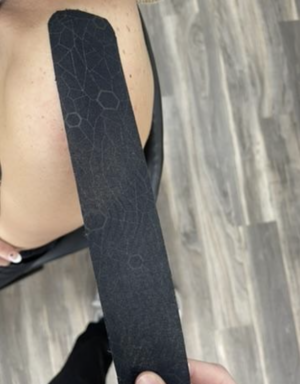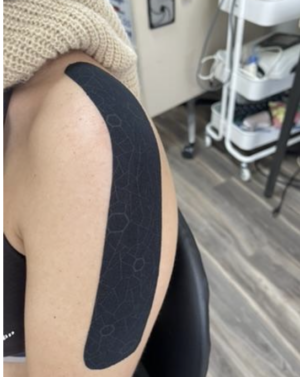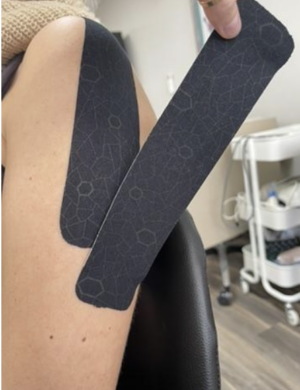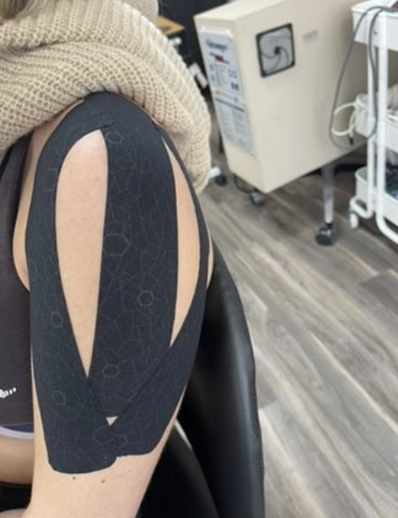How to use Kinesiology Taping for Shoulder Subluxation
Filed under Treatments
How to us Kinesiology Tape for Shoulder Subluxation
By: Tayler Roost
What is shoulder subluxation?
Shoulder subluxation is a dislocation of the glenohumeral joint. This can be classified as traumatic, non-traumatic, or neurological. A traumatic shoulder subluxation can be caused by contact sports or repetitive shoulder movements. A non-traumatic shoulder subluxation can be caused indirectly by another injury such as a rotator cuff tear. A neurological shoulder subluxation can stem from diagnoses such as a stroke, spinal cord injury, or brachial plexus injury. Whatever the category of subluxation is, it affects the person’s ability to functionally use their arms, especially during lifting, flexing, and abducting their affected shoulder.
How to know when someone has shoulder subluxation?
The person will usually present with pain in the shoulder, loss of range of movement, and a palpable gap between the humeral head and the acromion. The subluxation is typically measured in finger width. Special tests can be completed as well to identify if there is a subluxation such as the load and shift test, apprehension test, and relocation test.
How to use kinesiology tape for subluxation support:
- Cut 3 strips of kinesiology tape into 6in-8in pieces with rounded corners

- Anchor at the top of the deltoid


- Add a second piece, anchoring at mid-arm, stretching to approximately 30-50%, and attaching at the upper trapezius with shoulder approximated
- Add a third piece following the same steps as above anchoring at mid-arm, stretching to approximately 30-50%, and attaching at AC joint area with shoulder approximated


- Rub to adhere and they should be good to go! Ensure skin integrity and patient satisfaction after application.
Reference:
Chang, K., & Vitoonpong, T. (2023). Shoulder subluxation – statpearls – NCBI bookshelf.
National Library of Medicine. https://www.ncbi.nlm.nih.gov/books/NBK507847/
3 Comments
Leave a Comment
More To Read
Hand Therapy as a New Grad or Student
Tips for Getting Prepared for hand therapy as a new grad or a Level II Fieldwork Everything you need to know in hand therapy starts with the upper extremity anatomy. Here is a quick checklist to review and hopefully help get you started in your new hand therapy setting. By: Tristany Hightower I suggest, as…
Read MoreOutcomes of Dorsal Bridging Plates
Outcomes of Dorsal Bridging Plates Fares, A. B., Childs, B. R., Polmear, M. M., Clark, D. M., Nesti, L. J., & Dunn, J. C. (2021). Dorsal Bridge Plate for Distal Radius Fractures: A Systematic Review. The Journal of Hand Surgery. https://doi-org.methodistlibrary.idm.oclc.org/10.1016/j.jhsa.2020.11.026 The Skinny Distal radius fractures (DRF) are a common injury that we see in…
Read MoreTop 5 Hand Therapy Toys for Kids
Many therapists in hand therapy clinics have a lot of tools for their adult patients, but may not have as many tools for the less common pediatric patient. With nearly 20 years experience in pediatrics, we’ve compiled a list of our top 5 picks for tools to use with pediatric patients in hand therapy. We…
Read MoreBrachial Plexopathy Case Example in Hand Therapy
Brachial Plexopathy Case Example in Hand Therapy (plexopathy examples) One of the recent cases we have seen is a 13-year old with a brachial plexus injury. We are seeing the patient post-surgery for tendon transfers to increase functional use of his left upper extremity (LUE). Before the surgery, he could not extend the wrist and…
Read MoreSign-up to Get Updates Straight to Your Inbox!
Sign up with us and we will send you regular blog posts on everything hand therapy, notices every time we upload new videos and tutorials, along with handout, protocols, and other useful information.







This article on kinesiology taping for shoulder subluxation is very informative. I appreciate the detailed instructions and emphasis on proper assessment. The examples and videos provided make it easy to understand and implement. Thank you, Hand Therapy Academy, for this valuable resource!
Is there missing information for the first strip? All it says is anchor at deltoid but not sure if the strip is initially beginning in mid arm laying down distal to proximal direction. Thanks!
Hello. Thanks for reaching out you are going to anchor the firsts piece from the upper traps and than apply a stretch of around 30% over the deltoid. I hope this helps. Miiranda